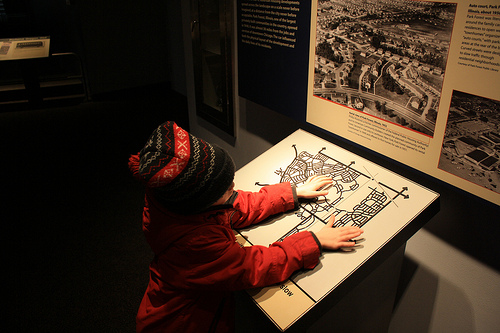Tactile maps help the blind find their way
A recent field study has provided new insight into the role of tactile maps in facilitating wayfinding for visually impaired persons.

A child using a tactile map. Image from linearclassifier.
12 participants who have varying degrees of visual impairment but “proximate ages and similar cognitive development” participated in the experiment, which took place at the Education Center of the Federal University of Pernambunco in Brazil. Each participant was presented with a tactile map featuring an unfamiliar route throughout the Education Center. Researchers Maria deFatima X.M.Almeida, Laura B. Martins, and Francisco J. Lima carried out the experiment, which was published in Procedia Manufacturing.
The building in which the experiment took place was not outfitted with any facilities to help blind persons navigate (e.g., Braille on signage throughout the building), so the tactile map was the only source for information regarding navigation in the building.
Each participant had the opportunity to study the tactile map for a specific length of time in order to familiarize themselves with the prescribed route and create a plan for navigation. The map featured numerous landmarks (e.g., walls, columns, rooms, sidewalks, stairs, etc.) with Braille labels.
Researchers describe the prescribed route as “complex.” They found that participants who merely attempted to memorize the route struggled more than those who were able to develop an idea of “space.” The latter strategy “triggered some elements of the environment in relation to the structure of the route, hence facilitating [participants’] special orientation.” The former strategy, however, resulted in “hesitations and route deviations.”
In other words, remembering “two rights, then a left, then another right” doesn’t work nearly as well as being able to conceptualize being in a hallway and then moving forward until you reach a fountain, at which point you turn right and proceed until the floor changes from carpet to tile.
Understanding the importance of spatial knowledge and context to inform wayfinding, the researchers suggest that, while tactile maps are extraordinarily beneficial — and probably critical — to facilitate wayfinding for visually impaired persons, they aren’t enough. Instead, the researchers recommend, tactile maps should “not be studied in isolation but rather from a systemic view of ergonomics that puts [them] as part of an information system that favors decision making across the map.
This finding has implications for signage that could help visually impaired persons navigate. It’s not enough to provide a map with Braille on it. It’s also important to provide landmarks, benchmarks, and spatial context that promote decision-making and environmental awareness. Beyond creating a highly contextualized initial tactile map, this research suggest that it would be helpful to provide additional information along the route, such as Braille room labels, that reinforce an individual’s route-related decisions once he or she has moved away from the map.
Of course, perhaps the biggest limitation of a tactile map is that, assuming it’s anchored in one place at the entrance of a building, once you’re away from it, you’re on your own. While a mobile electronic version of a wayfinding map would eliminate the possibility of tactile features, it could provide audio-based navigation that offers both turn-by-turn directions and spatial context with landmarks.
Title III of the Americans with Disabilities Act (ADA) of 1990 states that “no individual may be discriminated against on the basis of disability with regards to the full and equal enjoyment of the goods, services, facilities, or accommodations of any place of “public accommodation.” That means that hotels, public schools, and other public places must ensure that visually impaired persons have the same opportunities to wayfind as someone who is fully sighted. If a Braille map isn’t enough, more needs to be done.










